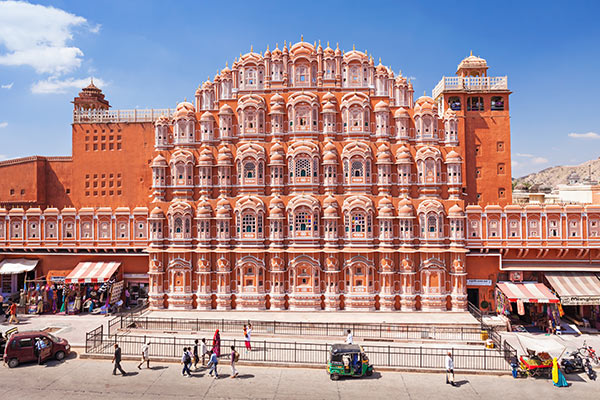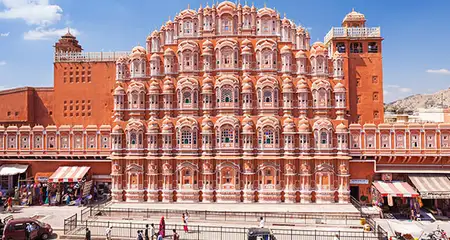With a history of over 200 years, Hawa Mahal is perhaps the most iconic monument in Jaipur. What makes this palace one of the top attractions in Jaipur for travelers is its unique architecture that comprises 953 windows. If the Pink City of India is next on your list of holiday destinations, keep aside some time to explore this iconic structure once you step out of your hotels in Jaipur.
Keen to know more about this heritage structure? This blog brings to you all the details of Hawa Mahal in Jaipur, including its history, architecture, entry fee, timings, and other details.
Hawa Mahal Information:
| Location | Badi Choupad |
| Timings | 9:00 am to 4:30 pm; every day |
| Entry Fee | ₹ 50 for Indians; ₹ 200 for foreigners |
| Year of Establishment | 1799 |
| Height | 50 meters |
| Commissioned by | Maharaja Sawai Pratap Singh |
| Material Used | Red and pink sandstone |
| Also Knows as | Palace of Breeze |
| Architect | Lal Chand Ustad |
| Architectural Style | Fusion of Islamic, Mughal, and Rajput architectural styles |
Hawa Mahal: History
Hawa Mahal was built by Kachhwaha Rajput ruler Maharaja Sawai Pratap Singh in the year 1799. When the maharaja saw the structure of Khetri Mahal in Jhunjhunu, Rajasthan, he was so impressed that he decided to build a palace modeled on it. Hawa Mahal, also called the Palace of Breeze, was the result of that inspiration.
This five-storied structure was designed by Lal Chand Ustad as an extension of the City Palace. Starting from the City Palace’s edge, Hawa Mahal extends to the women’s chambers aka zenana. During those days, the Purdah system was strictly followed and Royal Rajpur women weren’t allowed to show their face to strangers or even appear in public. The palace comprises 953 windows which enabled them to get a glimpse of the day-to-day activities and festivities happening on the street below without appearing in public.
Hawa Mahal Architecture
Hawa Mahal, one of the best places to visit in Jaipur, features a splendid fusion of Islamic, Mughal, and Rajput architectural styles. Its domed canopies, floral patterns, lotus motifs, and fluted pillars, all reflect the rich Rajput style. Complementing these elements is the filigree work in stone and lavish arches, both of which draw influence from the Islamic style of architecture.
Designed in red and pink sandstone, this one-of-its-kind palace boasts of a pyramidal shape. It has five stories and rises up to a height of 50 feet. The 953 windows featured on the front part of the palace lend it a honeycombed hive look. Thanks to the exceptional latticework on these windows, the palace experiences a cooling effect as the breeze blows in through them. Delicately designed hanging cornices are another attractive aspect of Hawa Mahal’s architecture.
The interiors of the palace consist of pillared chambers and minimally ornamented corridors that reach up to the top floor. Patios adorn the front part of the first and second floors. Unlike the lower two floors, the top three floors have a width that’s not more than a single room. There are fountains adorning the center of the building’s courtyard.
Hawa Mahal: Today
Today, a visit to the Hawa Mahal counts among the most interesting things to do in Jaipur because of its architectural beauty. The Unit Trust of India has extended its hand to maintain this unique historical structure and has adopted it for the purpose. The building is under the control of the Archaeological Department of the Government of Rajasthan. The palace was renovated in 2006 at an estimated expense of 4.568 million rupees to lend it a facelift.
The best time to visit Hawa Mahal is during the sunrise and sunset hours when the golden sun rays light up the whole red and pink structure in a spellbinding manner.
Hawa Mahal Museum
There is an archaeological museum located in the courtyard of the Hawa Mahal that displays a fine collection of antiques, weapons, and other items used by the royals. The museum was established in 1983 and will give you a glimpse into the royal past of the region.
Major exhibits: Arrow heads, fish hooks, terracotta items, a storage vessel dating back to the 2nd century, etc.
Lesser Known Facts about Hawa Mahal
- Recently, the tourism department has illuminated the exteriors of Hawa Palace in an attempt to promote night tourism in the city.
- Unlike other palaces, there’s no entryway in the front of the palace. You need to enter through a door that exists at the side of the building.
- It was the favorite resort of Maharaja Jai Singh who loved Hawa Mahal for its cooling effect as well as decorated interiors.
- Each of the five floors of the Hawa Mahal has a temple in it. Sharad Mandir exists on the first floor while the Ratan Mandir with colorful glasswork is on the second floor. Vichitra Mandir, Prakash Mandir, and Hawa Mandir adorn the top three floors.
- There are no stairs to reach the upper floors of the palace. Ramps were built, instead, as it was easy to carry palanquins of Rajput royal ladies on ramps.
Attractions near Hawa Mahal
- Jantar Mantar (700 m)
- Govind Dev Ji Temple (750 m)
- City Palace (850 m)
- Jaipur Zoo (2 km)
- Albert Hall Museum (2.4 km)
- Raj Mandir Cinema (3.7 km)
- Dolls Museum (3.8 km)
- Central Park (4.4 km)
- Birla Mandir (4.5 km)
- Jal Mahal (5 km)
- Kanak Vrindavan Garden (5.3 km)
- Rambagh Palace (5.4 km)
- Amber Palace (7.9 km)
Hawa Mahal is located in a prime location in Jaipur and counts among the top historical places to visit in and around Jaipur. And while you are here, don’t forget to take some amazing pictures with this majestic palace as the backdrop.




























